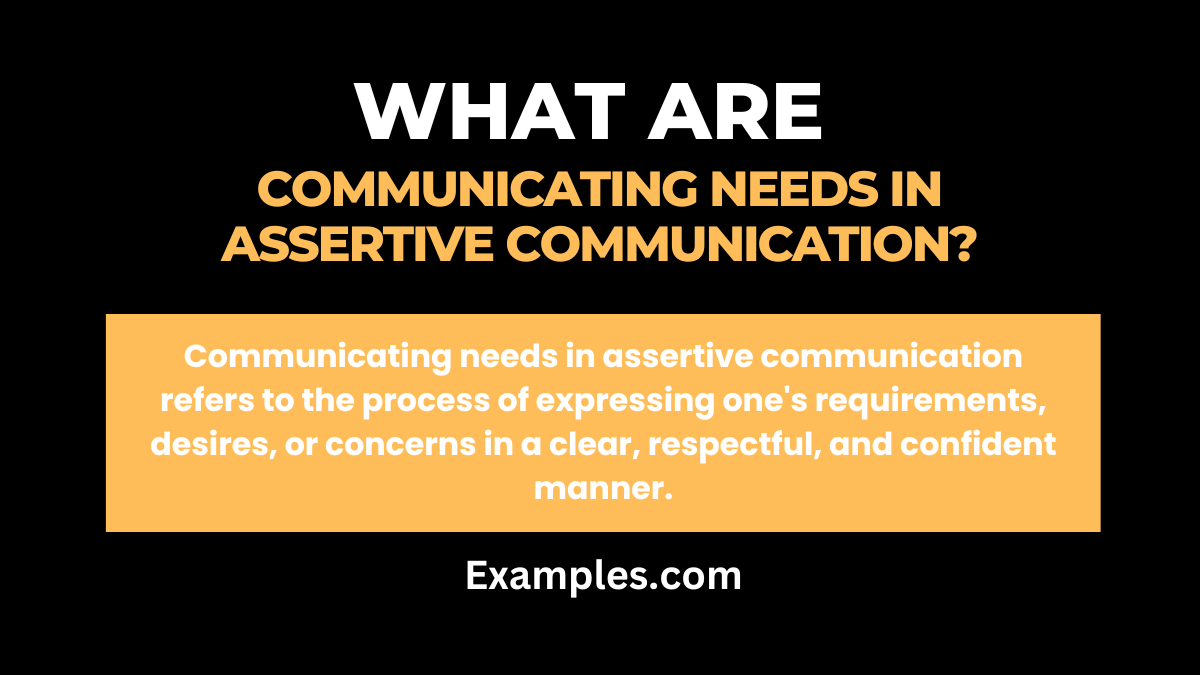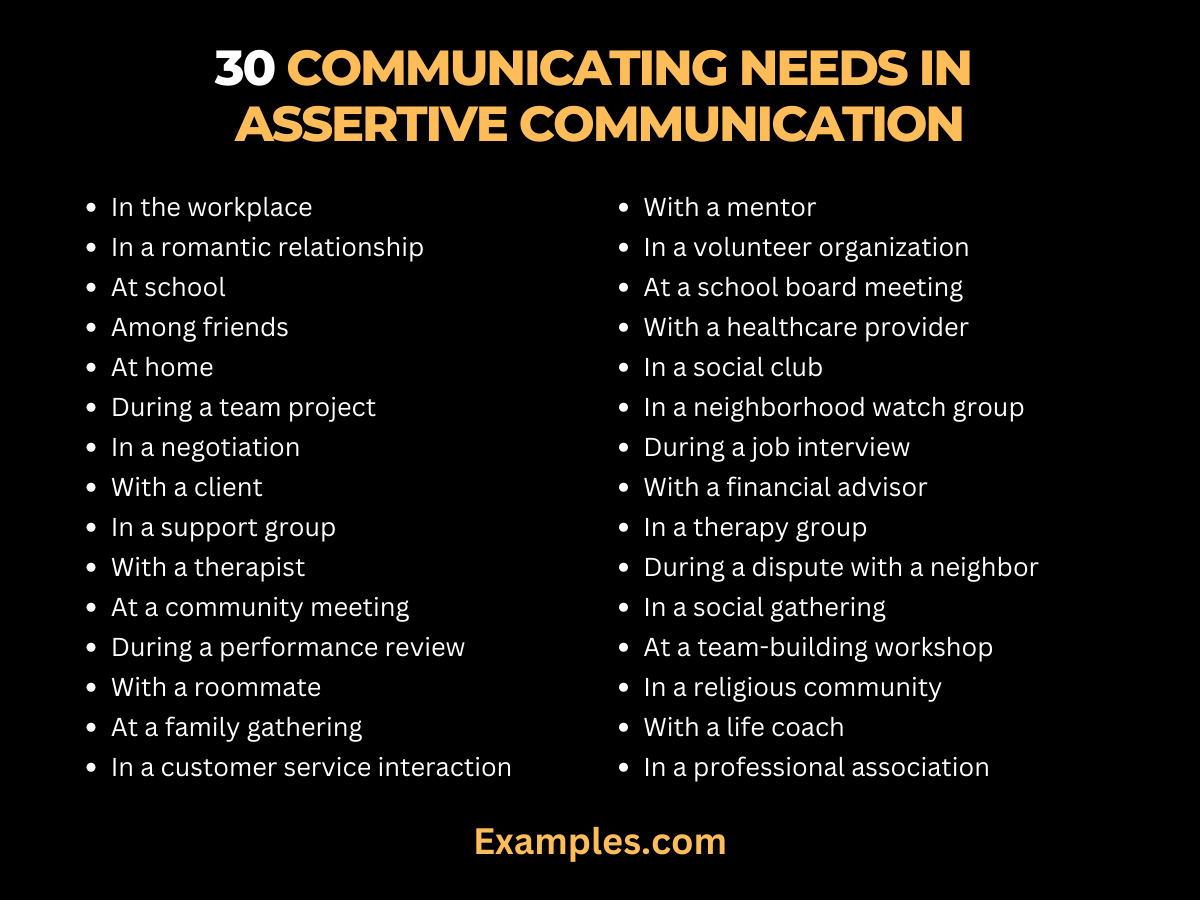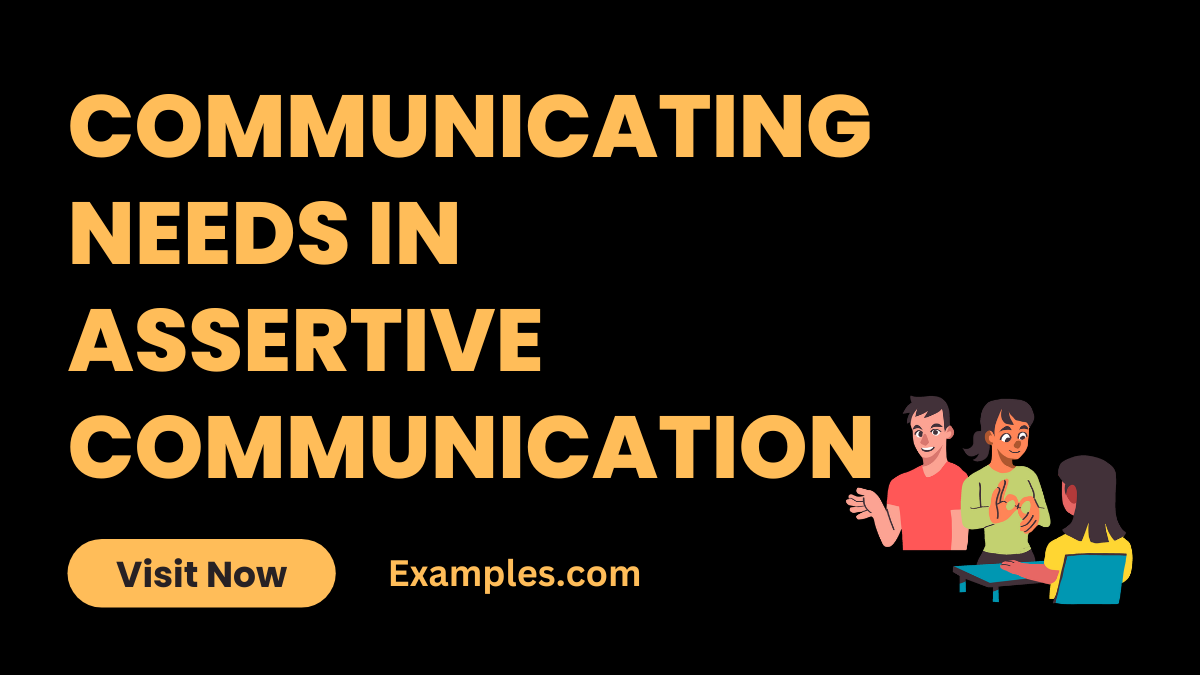Communicating Needs in Assertive Communication
In the art of assertive communication, effectively communicating needs is a game-changer. This complete guide, enriched with practical oral communication examples, offers a deep dive into expressing yourself assertively and respectfully. We’ll explore techniques like active listening and empathetic understanding, demonstrating through real-life scenarios how to articulate your needs while maintaining positive interactions. Whether in personal or professional settings, these skills are crucial for fostering understanding and respect in every conversation. Let’s embark on this journey to master assertive communication.
What are Communicating Needs in Assertive Communication?

Communicating needs in assertive communication refers to the process of expressing one’s requirements, desires, or concerns in a clear, respectful, and confident manner. It involves effectively communicating what you need or want while considering the feelings and rights of others. Assertive communication emphasizes open and honest expression without being passive or aggressive.
In assertive communication, individuals use “I” statements to express their needs and feelings, which promotes constructive dialogue and problem-solving. This approach allows individuals to assert themselves in a way that fosters understanding and maintains positive relationships. It is a valuable skill in various personal, professional, and social interactions, as it enables individuals to advocate for themselves while respecting the boundaries of others.
30 Communicating Needs in Assertive Communication
In the realm of assertive communication, effectively communicating your needs is paramount. It involves expressing your desires, preferences, and requirements clearly and confidently while respecting the rights and feelings of others. This skill is indispensable in personal relationships, the workplace, and various aspects of life. Mastering the art of communicating needs in assertive communication empowers you to maintain healthy boundaries, resolve conflicts constructively, and foster better understanding among peers. Explore these 30 unique examples below to grasp the essence of communicating needs assertively and enrich your interpersonal interactions.

- In the workplace: When requesting a more flexible work schedule to accommodate personal commitments, express your needs clearly and professionally. Explain how this change will not disrupt productivity, ensuring a positive outcome for both you and your employer.
- In a romantic relationship: If you need more emotional support from your partner, openly discuss your feelings and why this support is vital to you. This can lead to improved communication and a stronger bond.
- At school: When seeking clarification from your teacher about an assignment, approach them with respect and express your need for a better understanding. This shows your commitment to learning.
- Among friends: If you need more alone time, tell your friends that you value their company but also require personal space. This honest approach maintains your friendships while respecting your needs.
- At home: When asking family members to help with household chores, use assertive communication to explain your need for assistance. This promotes a fair distribution of responsibilities.
- During a team project: When you need additional resources to meet project deadlines, communicate this need clearly to your team, outlining the potential benefits and outcomes of receiving these resources.
- In a negotiation: When making a business proposal, assertively express your need for a fair deal, backed by evidence and a persuasive argument to strengthen your position.
- With a client: When a client demands an unrealistic timeline, assertively communicate your need for more time to deliver a quality product or service, emphasizing the long-term benefits of this approach.
- In a support group: Share your need for a safe and non-judgmental environment to discuss personal issues openly. This encourages trust and healing within the group.
- With a therapist: When attending therapy, be clear about your therapy goals and the need for specific techniques or approaches that resonate with you, ensuring a tailored and effective experience.
- At a community meeting: Express your need for inclusivity and diversity within the community, explaining how it can benefit everyone and foster a sense of belonging.
- During a performance review: Communicate your need for constructive feedback and guidance from your supervisor to enhance your professional growth and development.
- With a roommate: When discussing household responsibilities, assertively express your need for a clean and organized living space, ensuring shared expectations and harmony.
- At a family gathering: If you need support with a personal issue, openly discuss it with your family, emphasizing your need for their understanding and assistance.
- In a customer service interaction: When dealing with a service issue, assertively express your need for a prompt resolution and fair compensation, ensuring your rights as a customer are respected.
- With a mentor: Clearly communicate your need for guidance and mentorship in specific areas of your personal or professional life, enabling you to grow and learn effectively.
- In a volunteer organization: Express your need for a streamlined and efficient process to complete tasks, highlighting how it benefits the organization’s mission and goals.
- At a school board meeting: Assertively convey your need for improved educational resources, explaining how it will positively impact the students and the community.
- With a healthcare provider: When discussing your treatment plan, be clear about your need for information and options, allowing you to make informed decisions about your health.
- In a social club: Share your need for a more varied and engaging selection of activities, enhancing the club’s appeal to a wider audience.
- In a neighborhood watch group: Communicate your need for enhanced security measures, emphasizing how it benefits the safety and well-being of the community.
- During a job interview: Express your need for a supportive and inclusive workplace culture, indicating your commitment to contributing positively to the organization.
- With a financial advisor: Clearly state your need for a customized financial plan aligned with your goals, ensuring your financial well-being.
- In a therapy group: Share your need for a respectful and non-judgmental space to discuss personal challenges, fostering a supportive group dynamic.
- During a dispute with a neighbor: Assertively express your need for a peaceful resolution, emphasizing the importance of maintaining neighborly relations.
- In a social gathering: If you need a quieter environment, assertively communicate your need for a less noisy atmosphere, ensuring your comfort and enjoyment.
- At a team-building workshop: Express your need for activities that promote collaboration and teamwork, fostering a positive learning experience.
- In a religious community: Communicate your need for spiritual guidance and support, enhancing your sense of belonging and faith.
- With a life coach: Clearly define your personal and professional goals, expressing your need for guidance and accountability to achieve them.
- In a professional association: Assertively convey your need for networking opportunities and resources, highlighting the potential benefits for your career growth and development.
Needs in Assertive Communication Skills for Students
Assertive communication skills are crucial for students, aiding in their personal, academic, and future professional growth. This guide emphasizes why students must develop these skills, focusing on their ability to express thoughts and needs clearly and respectfully. From classroom interactions to group projects, assertive communication fosters a conducive learning environment. It also prepares students for real-world challenges, enhancing their ability to navigate various situations with confidence and empathy. These skills are not just academic necessities; they’re life skills.
- Participating in Class Discussions: “I have a different perspective on this topic. May I share my thoughts?”This shows students asserting their right to participate in class, contributing unique viewpoints respectfully.
- Requesting Clarification on Assignments: “I’m not clear about this aspect of the assignment. Could you please explain it further?”Here, the student is taking initiative to seek clarity, ensuring they understand the task fully.
- Dealing with Peer Pressure: “I understand your point, but I’m not comfortable with that. Let’s find a different approach.”This example demonstrates students standing up for themselves in peer interactions, maintaining their personal values.
- Expressing Disagreement with Respect: “I see your point, but I have a different opinion. Can we discuss this?”It encourages students to express disagreement in a constructive manner, promoting healthy debates.
- Asking for Help: “I’m struggling with this concept. Can someone explain it to me?”Assertiveness here is about acknowledging the need for help and actively seeking assistance.
- Navigating Group Projects: “I think my strengths would be best utilized in this area of the project. Is that okay with everyone?”Students learn to assertively express their preferences and strengths in collaborative settings.
- Addressing Bullying: “I don’t appreciate those comments. Please stop.”This empowers students to stand up against bullying in a firm yet respectful manner.
- Seeking Academic Support: “I believe I would benefit from extra tutoring in this subject. Can we arrange that?”Students assert their need for additional academic support to improve their learning outcomes.
- Expressing Personal Boundaries: “I’m not comfortable with sharing that information. Let’s keep our focus on the project.”Here, students learn to set and communicate personal boundaries within peer interactions.
- Handling Criticism Constructively: “I understand your critique. Can you suggest how I might improve?”
Why Do Assertive Communication Skills Need in the Workplace?
Assertive communication skills are essential in the workplace for several important reasons. In this comprehensive guide, we will explore why these skills are crucial for professional success and how they benefit both employees and organizations.
1. Effective Collaboration
In a modern workplace, collaboration is key to accomplishing tasks and projects. Assertive communication fosters effective collaboration by ensuring that team members can express their ideas, concerns, and needs clearly and respectfully. This leads to improved teamwork and better outcomes.
2. Conflict Resolution
Conflicts can arise in any workplace, but how they are handled makes a significant difference. Assertive communication skills enable employees to address conflicts in a constructive manner. By openly discussing issues and finding mutually beneficial solutions, conflicts can be resolved more efficiently.
3. Enhanced Problem-Solving
Assertive individuals are more likely to engage in problem-solving activities. They can identify challenges, propose solutions, and seek feedback without fear of retribution. This proactive approach leads to quicker and more effective problem resolution.
4. Increased Productivity
When employees can communicate their needs and preferences assertively, they are more likely to work in conditions that suit their strengths. This leads to increased job satisfaction and productivity, benefiting both the individual and the organization.
5. Better Decision-Making
Assertive communication encourages active participation in discussions and decision-making processes. Employees feel confident in sharing their perspectives, which leads to more well-informed decisions and innovative solutions.
6. Enhanced Leadership
Leaders who practice assertive communication can inspire and motivate their teams effectively. They set clear expectations, provide constructive feedback, and create a positive work environment that encourages growth and development.
7. Reduced Stress
Suppressing one’s thoughts and feelings at work can lead to stress and burnout. Assertive communication allows individuals to express themselves honestly, reducing workplace stress and contributing to overall well-being.
8. Respectful Work Environment
A workplace that values assertive communication fosters a respectful environment where all voices are heard and respected. This promotes inclusivity and diversity, which can lead to a more harmonious and innovative workplace culture.
9. Career Advancement
Employees who demonstrate assertive communication skills often stand out as effective communicators and problem solvers. These qualities can contribute to career advancement opportunities and professional growth.
10. Organizational Success
Ultimately, organizations that prioritize assertive communication benefit from improved employee morale, reduced conflicts, increased productivity, and better decision-making. This translates to overall success and competitiveness in the marketplace.



